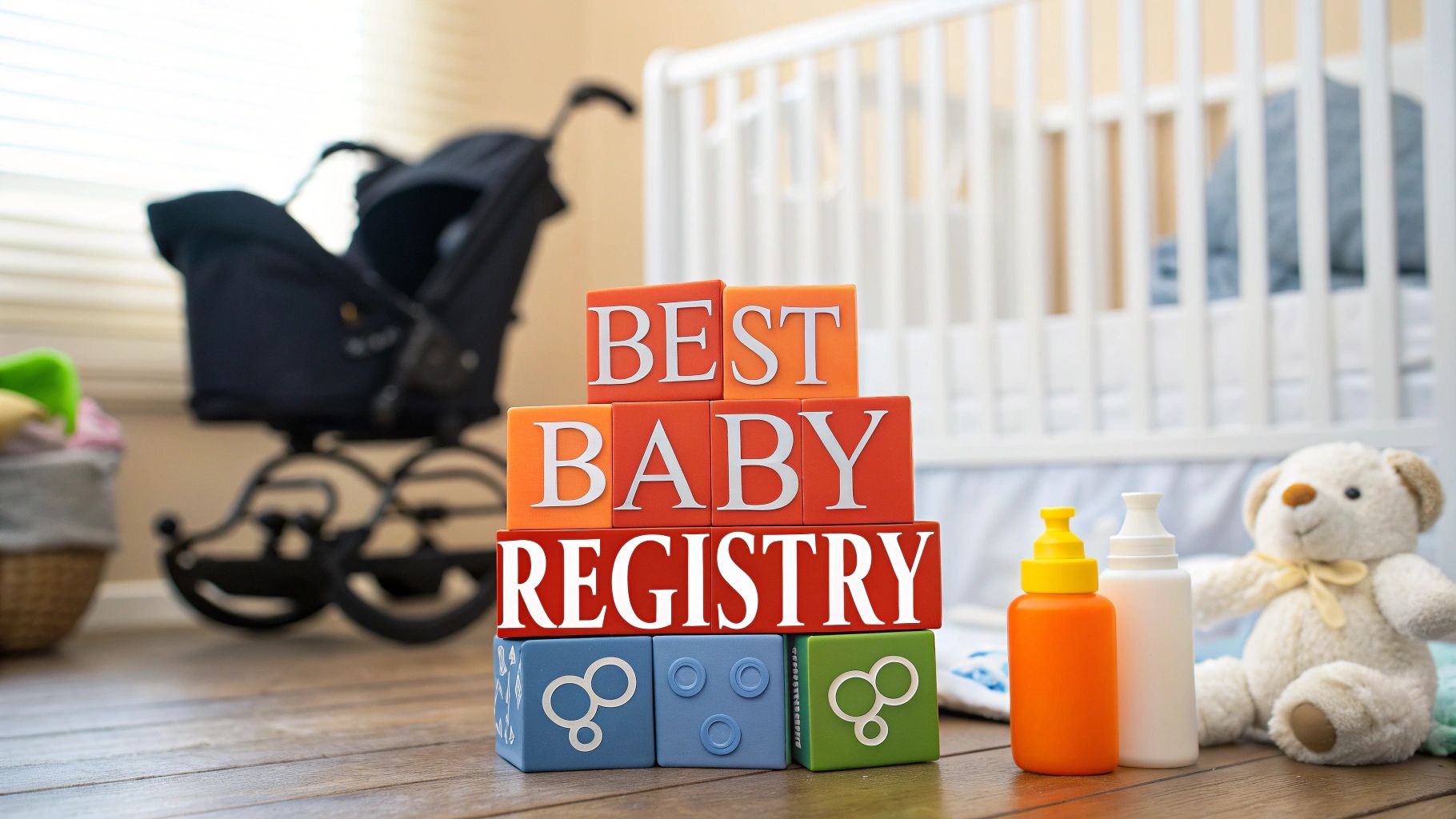
Your Guide to the Best Baby Registry Items
Creating a baby registry involves navigating three key areas: fundamental safety essentials like car seats and cribs, daily necessities for feeding and diapering, and lifestyle-specific items that complement your family's unique needs, such as a jogging stroller or a baby carrier for hiking. Categorizing your needs this way helps streamline the process and ensures all essential areas are covered, making you feel prepared and confident.
Building Your Registry Without the Overwhelm
Starting a baby registry can feel like preparing for a journey to an unknown destination. The sheer volume of products can be overwhelming. This guide is designed to cut through the noise and help you build a practical, personalized, and genuinely useful registry.
We will walk through the core categories every new parent should consider, starting with the absolute must-haves and then moving on to items that enhance convenience and comfort. You will learn how to evaluate your lifestyle, home environment, and budget to select products that will truly serve your family's needs.
This process is about more than just creating a shopping list; it's about establishing a support system for this new chapter in your life. By focusing on practical utility over fleeting trends, you'll create a wish list that serves a meaningful purpose for you and your new baby.
The Three Pillars of a Thoughtful Registry
Breaking down your list of the best baby registry items into three main pillars can make the task feel much more manageable. This framework helps you distinguish between what is truly essential and what is simply a nice-to-have.
-
Core Essentials: These are the non-negotiable items every baby requires for safety and basic care. This includes a safe sleep space, a certified car seat for transportation, and the fundamental gear for feeding and diapering.
-
Lifestyle & Personal Fit: This category is tailored to your unique circumstances. Do you have an active, on-the-go lifestyle? Do you live in a small apartment? Are you planning to breastfeed or formula-feed? Your answers will guide you toward specific items like a lightweight stroller, a compact high chair, or a particular type of breast pump.
-
Budget & Long-Term Value: This pillar involves thinking about the bigger picture. It includes high-value items that friends and family can contribute to as a group, as well as products designed to grow with your child, such as a convertible crib. Planning this aspect ensures you get the most value from every gift.
This infographic provides a clear visual of how these pillars work together.
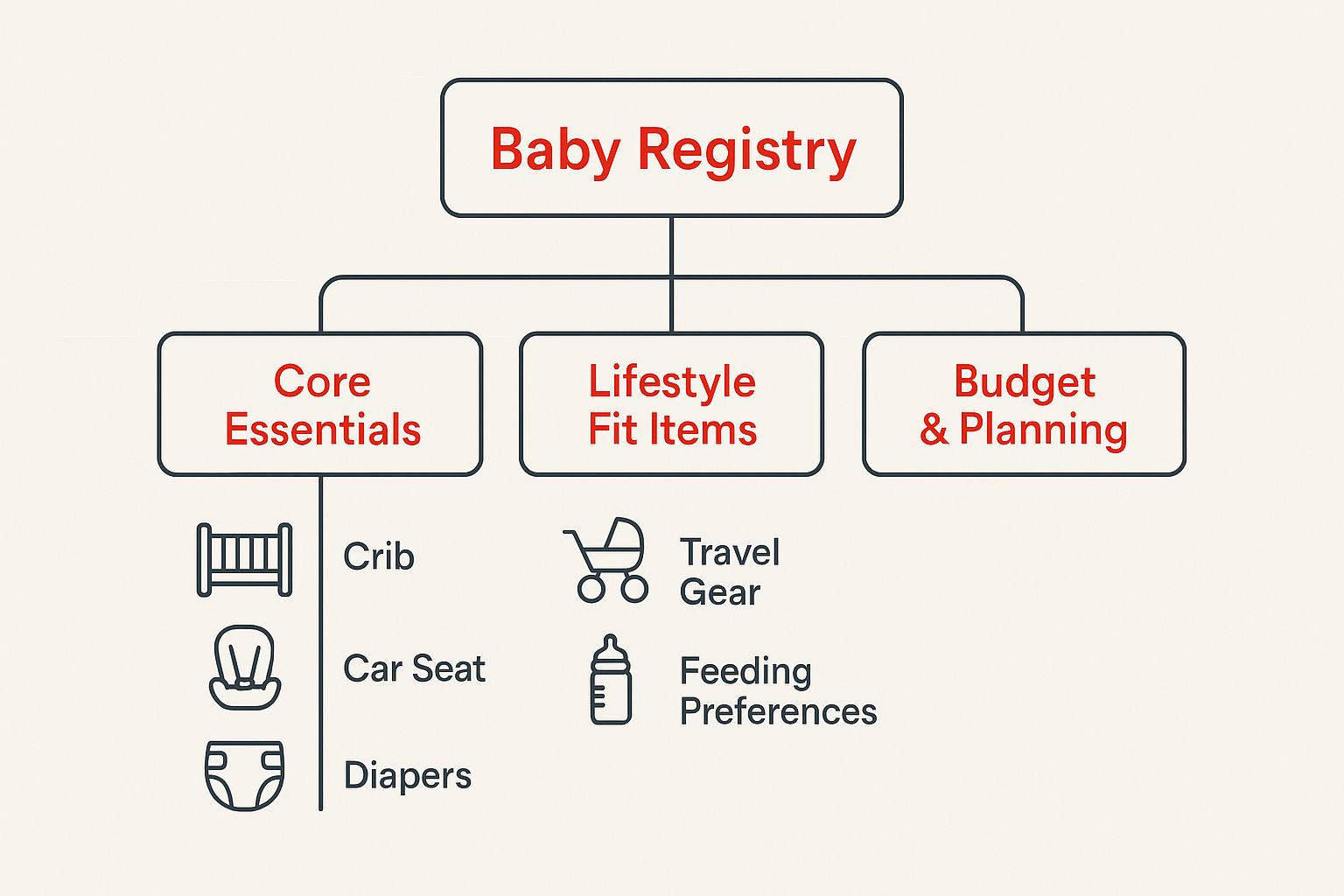
As you can see, a well-planned registry balances fundamental needs with your personal lifestyle and budget. The objective is to replace feelings of being overwhelmed with the quiet confidence that comes from being well-prepared for your new arrival.
Creating a Safe and Soothing Nursery
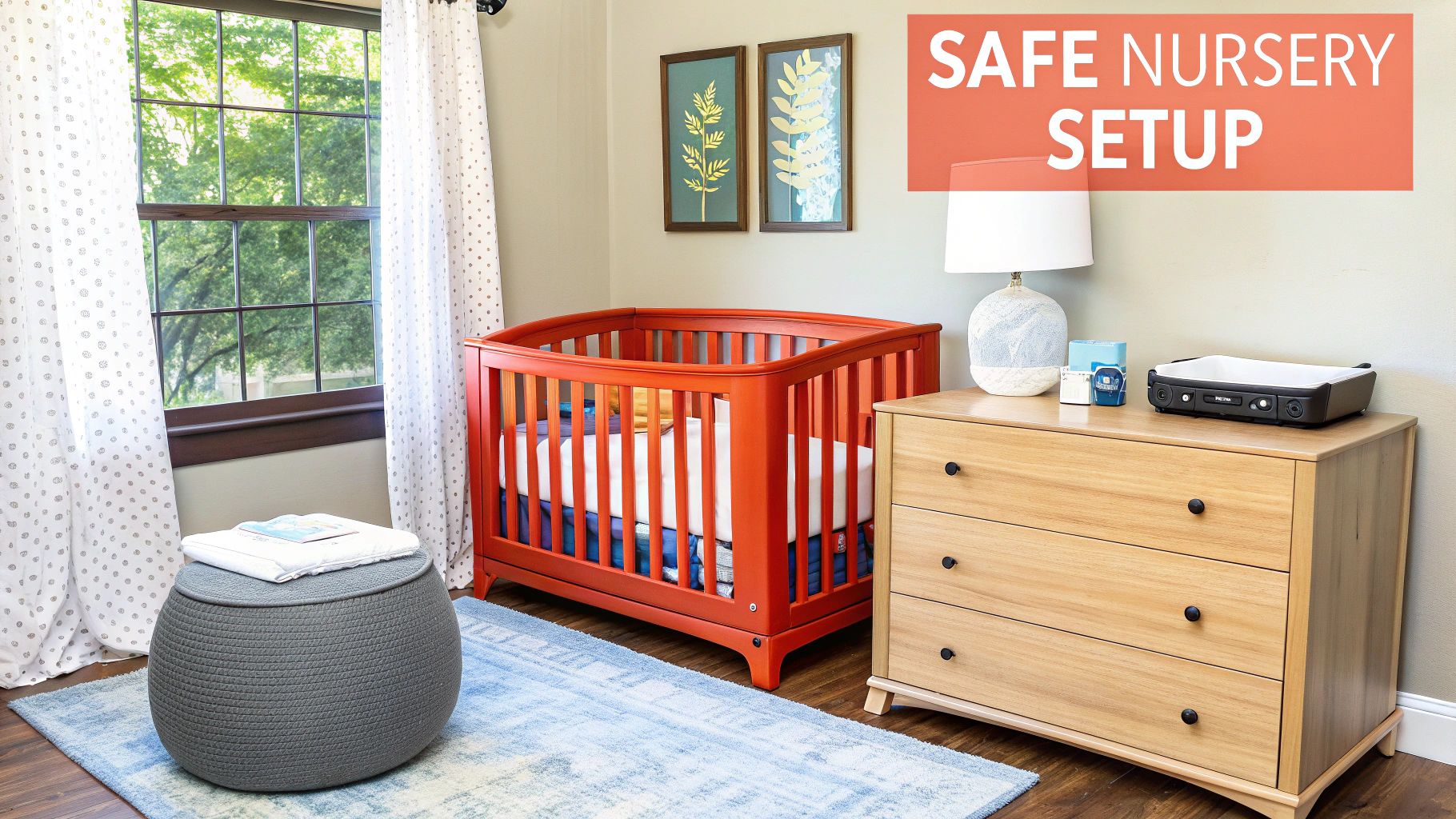
Your baby's nursery will be their first environment—a sanctuary for sleep, comfort, and development. While it's easy to get caught up in decor, the foundation of a great nursery is safety and tranquility. The items in this category are often the most significant investments, so prioritizing durability and adherence to safety standards is paramount.
The crib is the anchor of the room. It's more than furniture; it's the centerpiece of your baby's sleep environment. When evaluating options, ensure any model you consider meets current safety regulations, which include fixed sides and properly spaced slats.
This focus on core, durable items reflects a broader trend. The US market for baby durable products is projected to reach $10.18 billion by 2025. This statistic highlights a shift among parents towards practicality, sustainability, and even smart technology, with IoT-enabled cribs that track sleep patterns becoming more common.
Choosing the Right Crib and Mattress
When browsing for cribs, you will primarily encounter two types. The convertible crib is a popular choice for its long-term utility, transforming from a crib to a toddler bed and sometimes even a full-size bed frame. This adaptability makes it a wise investment.
Alternatively, a mini-crib is an excellent solution for smaller living spaces or for parents who plan to keep the baby in their room for the first few months. While they are space-efficient, it's important to remember that a baby will outgrow one more quickly than a standard-size crib.
The mattress is just as crucial as the crib. For infant safety, a baby's mattress must be firm and flat, fitting snugly inside the crib with no gaps around the edges. A breathable cover is a beneficial feature for both comfort and airflow, and it protects the mattress from inevitable messes.
Here is a simple test for mattress firmness: Press your hand down in the center and near the edges. A safe mattress will spring back immediately and will not retain the impression of your hand.
Nursery Must-Haves vs Nice-to-Haves
Distinguishing between essential items and optional extras can be challenging. This table is designed to help you prioritize your registry and budget for the nursery.
| Item Category | Must-Have Feature | Nice-to-Have Feature | Why It Matters |
|---|---|---|---|
| Crib & Mattress | Meets current safety standards, firm mattress | Convertible design, organic materials | Safety is the priority. A safe sleep space is non-negotiable. Convertibility offers long-term value. |
| Changing Area | Secure changing pad with straps | Standalone changing table with storage | A safe, stable surface for diaper changes is essential. A dedicated table adds organizational convenience. |
| Sleep Aids | Blackout curtains | Smart sound machine with app control | A dark, quiet environment promotes better sleep for the baby and parents. Basic versions are as effective as high-tech ones. |
| Monitoring | Reliable audio or video monitor | Monitor with breathing/movement sensor | Peace of mind is the primary goal. You need to be able to see or hear your baby; additional tracking is a matter of personal preference. |
Ultimately, the objective is to create a room that is safe, functional, and calming. While "nice-to-haves" can add convenience, they are not essential, especially in the beginning.
Building a Functional Nursery Space
Beyond the crib, a few key items contribute to a functional and soothing nursery. A dedicated changing station—whether a standalone table or a secure pad on a dresser—is invaluable for the frequent diaper changes. Look for a model with safety straps and raised edges.
Other essentials that significantly enhance the nursery environment include:
- Blackout Curtains: These are highly effective for promoting better sleep by signaling to your baby that it’s time to rest, regardless of the time of day.
- A Reliable Baby Monitor: Whether you choose a simple audio model or a video monitor with advanced features, this device offers invaluable peace of mind.
- A Sound Machine: The consistent, gentle hum of a white noise machine can be very effective. It mimics the sounds of the womb, helping to soothe a fussy baby and mask household noises.
These foundational items work together to create a calm, secure environment. As you set up the nursery, it is also an ideal time to consider safety throughout your home. You can find valuable information in our guide on how to childproof your home.
Choosing Your Feeding and Soothing Gear
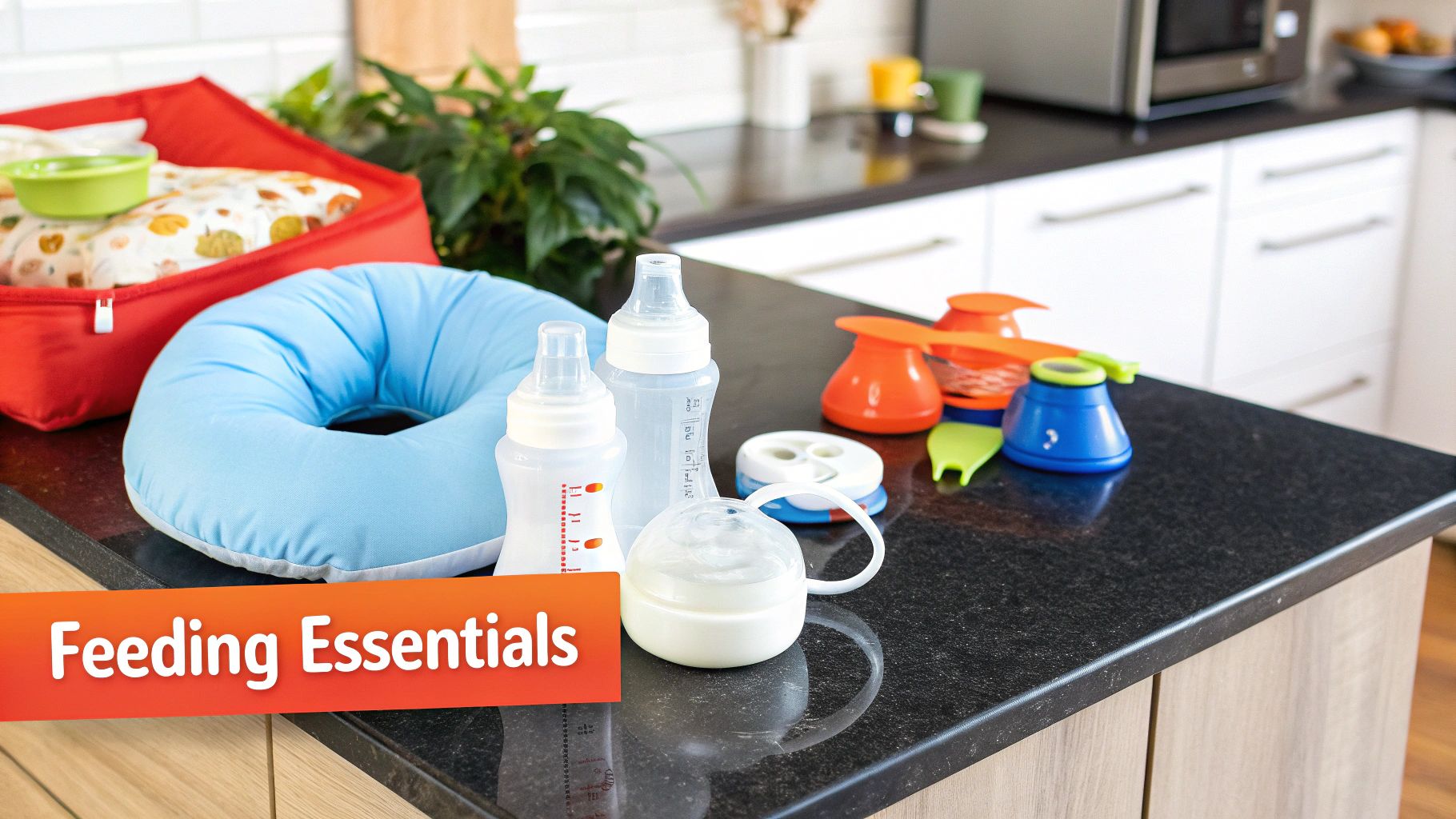
Feeding your newborn will quickly become a central part of your daily life. Having the right equipment can transform this experience from a source of stress into a smooth and successful routine. Whether you plan to breastfeed, formula-feed, or use a combination of both, preparation is key to creating more opportunities for bonding.
If you plan to breastfeed, a high-quality breast pump is a primary consideration. Many health insurance plans cover a hospital-grade pump, so it is worthwhile to investigate this benefit before making a purchase. Your comfort is also essential; a supportive nursing pillow can significantly reduce back and shoulder strain during long feeding sessions.
An efficient system for storing breast milk is also important. This includes collection bottles compatible with your pump, freezer-safe storage bags, and a simple method for labeling everything with dates to ensure no milk is wasted.
Navigating Bottles and Formula Prep
For parents planning to use formula, the variety of bottles available can be daunting. They come in different materials—plastic, silicone, and glass—and feature various designs, such as anti-colic vents and angled necks. A helpful strategy is to add a few different single bottles to your registry rather than a large set of one type. This allows you to discover which bottle your baby prefers.
Several devices can streamline the preparation process, including bottle sterilizers and warmers.
- Bottle Sterilizers: These machines use steam to eliminate 99.9% of germs on bottles, pacifiers, and pump parts. This provides peace of mind and is significantly more convenient than boiling water.
- Bottle Warmers: A warmer that can bring milk to the ideal temperature in minutes is invaluable, especially during nighttime feedings.
While all-in-one formula machines that mix and warm formula are available, they are a luxury, not a necessity. A reliable bottle warmer and a selection of suitable bottles are sufficient for establishing a smooth feeding routine.
Universal Feeding Essentials
Regardless of your chosen feeding method, certain items are universally useful. It's nearly impossible to have too many burp cloths to manage spit-up and spills; absorbent materials like cotton flannel or muslin are excellent choices. Similarly, a good supply of bibs will help protect your baby’s clothing from stains.
These seemingly small items are the workhorses of any feeding toolkit. Having them readily available makes the entire process cleaner and less stressful. As you settle into a rhythm, establishing a routine can be very beneficial. This baby feeding schedule template offers useful examples. By thoughtfully selecting these feeding items, you are setting the stage for a calmer, more confident experience.
Selecting Your Travel and On-the-Go Essentials
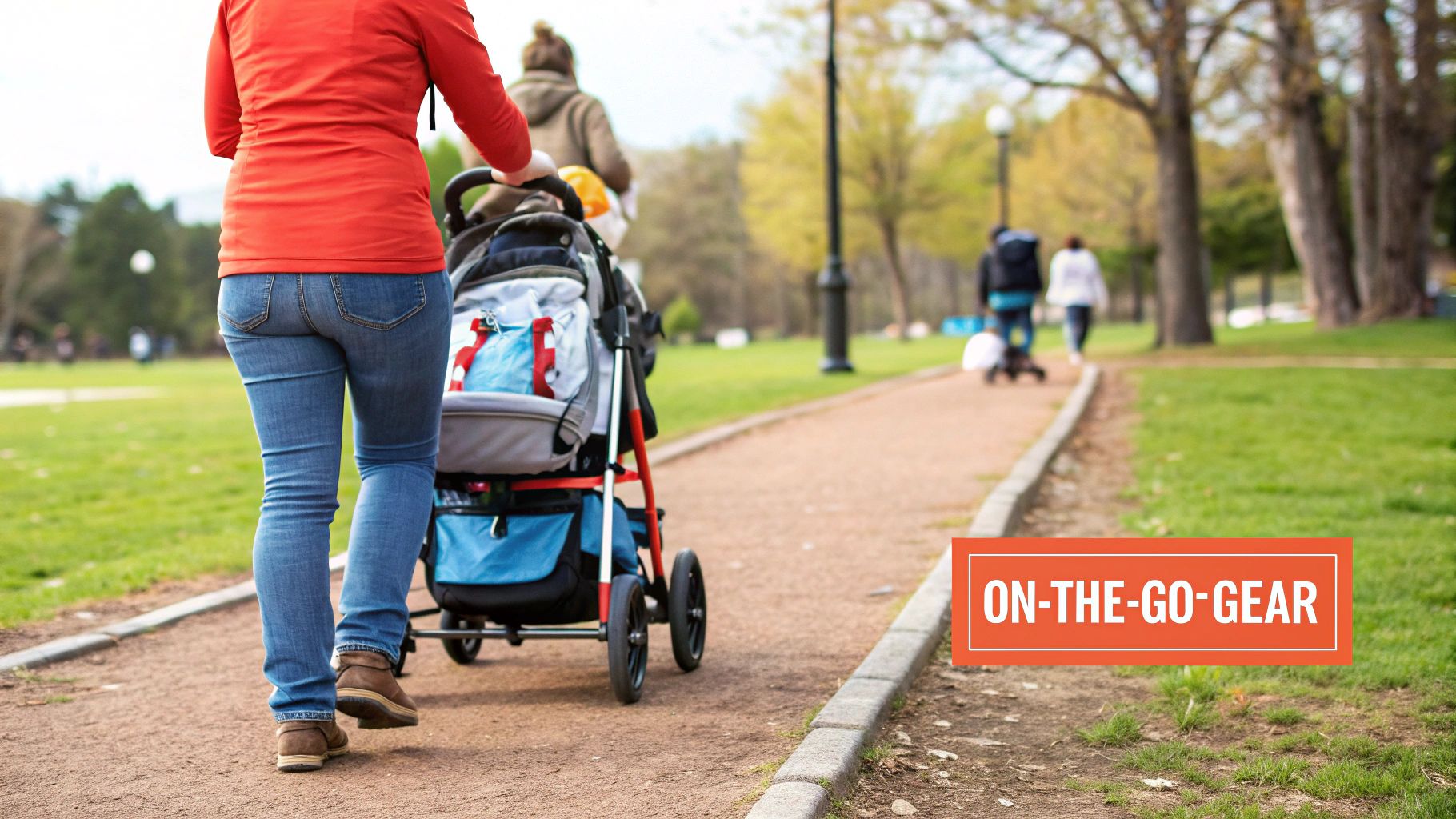
Leaving the house with a baby can feel like a significant undertaking, but with the right gear, it can become a simple and enjoyable adventure. Your travel essentials are among the most critical items on your registry, requiring a balance of safety, convenience, and suitability for your family's lifestyle. These items will be your trusted companions for everything from local errands to family vacations.
The cornerstone of your on-the-go equipment is the car seat. It is a non-negotiable safety item. Understanding the main types of car seats is the first step toward building your complete travel system.
Decoding Car Seats and Strollers
When researching travel gear, you will find two primary car seat options for newborns. Each has its advantages, and the best choice depends on your daily activities.
- Infant Car Seat: These are designed for newborns and small babies, typically used until around the first birthday. They are lightweight, portable, and click into a base that remains in your car. The ability to move a sleeping baby from the car to the house without disturbance is a significant benefit.
- Convertible Car Seat: This is a long-term investment. A convertible seat can be used from birth in a rear-facing position and later transitions to a forward-facing seat as your child grows, lasting for several years. However, they are heavy and designed to remain in one vehicle, sacrificing portability.
Many parents opt for a travel system, which bundles an infant car seat with a compatible stroller. The car seat clicks directly onto the stroller frame, making transitions seamless. When selecting a stroller, consider its weight, ease of folding (test this in-store if possible), and wheel type. Large, all-terrain wheels are ideal for parks, while smaller wheels offer greater maneuverability in urban environments.
The National Highway Traffic Safety Administration (NHTSA) provides free, easy-to-understand safety ratings for car seats. Before adding any model to your registry, it's wise to check its rating to ensure you are making a well-informed and confident choice.
The Anatomy of a Perfect Diaper Bag
Your diaper bag will function as your mobile command center, so practicality is paramount. While style is a consideration, focus on features that promote organization and preparedness. A well-designed diaper bag is a tool that can significantly reduce the stress of being out with your baby.
When comparing options, look for features that will simplify your life during chaotic moments.
Key Diaper Bag Features to Look For:
- Multiple Compartments: Separate, easily accessible pockets for diapers, wipes, and creams are essential for quick access during a diaper change.
- Insulated Pockets: These are a must-have for keeping bottles of milk or formula at the correct temperature while you are away from home.
- Built-in Changing Pad: A wipeable, foldable changing pad ensures you always have a clean surface, no matter where a diaper change is needed.
- Durable, Wipeable Fabric: Spills are inevitable. A bag made from a material that is easy to clean is a practical necessity.
Choosing your on-the-go gear is about finding the optimal balance between top-tier safety and features that align with your daily routines.
Stocking Up on Health and Hygiene Basics
Caring for your baby’s health and hygiene forms the foundation of your new daily routine. These items may not be the most exciting gifts on your registry, but they are the ones you will use most frequently. From bath time to the constant cycle of diaper changes, having the right supplies ensures these tasks run smoothly for both you and your baby.
The baby care market is substantial, projected to reach nearly USD 439.5 billion by 2032. This growth is driven by parents seeking safe, gentle, and effective products. Consulting trusted blogs and social media reviews can be a valuable way to navigate the options.
Creating a Gentle Bath Routine
Baths for newborns are more about a warm, soothing sensory experience than about cleaning. A dedicated infant tub is a highly practical item, offering secure support until your baby can sit up independently. Look for a model with a non-slip surface and a newborn sling for the early weeks.
With a suitable tub, a few key accessories can help create a calm, spa-like atmosphere.
- Baby-Safe Wash and Lotion: Choose fragrance-free and tear-free formulas designed for sensitive skin. Brands like Tubby Todd are often recommended by parents for addressing common skin issues such as baby acne or eczema.
- Soft Washcloths: A small number of very soft washcloths is sufficient to avoid irritating your baby's delicate skin.
- Hooded Towels: These are both practical and charming, effectively keeping a freshly bathed baby warm and cozy from head to toe.
A well-planned bath setup can transform a routine chore into a cherished bonding activity. For a comprehensive checklist, see our guide on essential items for a newborn’s first bath.
Mastering Diaper Duty
You will quickly become proficient at changing diapers, and a well-equipped station makes the task more pleasant. While the choice between disposable and cloth diapers is personal, a dedicated changing area is essential. A wipeable changing pad, such as the popular Keekaroo Peanut, is a practical choice that eliminates the need for constant laundering of fabric covers.
Do not underestimate the value of a quality diaper pail. While a regular trash can is an option, a specialized pail like the Ubbi or Munchkin Diaper Pail is designed to contain odors effectively—a feature you will greatly appreciate.
A quality diaper cream is another absolute must-have. Look for a formula containing zinc oxide, which creates a protective barrier to prevent diaper rash. Applying a thin layer at each change, particularly before long sleep periods, will help keep your baby’s skin comfortable.
Building a Baby First-Aid Kit
Finally, assembling a basic first-aid kit can provide significant peace of mind. It doesn't need to be extensive; just a few key items to manage minor issues. Start with a reliable digital thermometer, a nasal aspirator for congestion (the NoseFrida is a parent favorite), and a set of baby-safe nail clippers or a file to manage sharp fingernails. Having these essentials on hand means you are prepared for minor health concerns as they arise.
Building a Practical Newborn Wardrobe
It is easy to be captivated by adorable, tiny outfits, but during the early days of parenthood, practicality is paramount. Approach building your baby’s first wardrobe as if you are creating a functional capsule collection.
The objective is to acquire the workhorses of baby clothing—pieces that are suitable for sleeping, playing, and frequent diaper changes. A newborn's skin is exceptionally delicate, so soft, breathable fabrics like cotton or bamboo are essential.
Small design details can make a significant difference. For example, two-way zippers on sleep-and-plays simplify nighttime diaper changes. Bodysuits with lap-shoulder snaps allow you to pull a soiled outfit down over the baby's body instead of up over their head—a truly practical feature.
The Essential Clothing Checklist
To avoid accumulating a drawer full of clothes that are rarely worn, focus your registry on a practical number of key staples. Babies grow very quickly, so it is wise to register for items in several sizes, such as Newborn, 0-3 months, and 3-6 months.
Here is a quick-reference guide to help you build a solid foundation for the first three months.
Essential Newborn Clothing Checklist (First 3 Months)
This table outlines the absolute must-haves, recommended quantities, and key features that will simplify your daily routine.
| Clothing Item | Recommended Quantity | Key Features to Look For |
|---|---|---|
| Sleep-and-Plays | 6-8 | Two-way zippers, built-in footies or hand mitts |
| Bodysuits (Onesies) | 8-10 | Lap-shoulder snaps for easy changes, soft cotton fabric |
| Swaddles | 3-5 | Stretchy fabric for a snug fit, velcro or zipper closures |
| Pants/Leggings | 4-6 | Soft, stretchy waistbands that won't dig into the belly |
| Socks or Booties | 6-8 pairs | Styles that actually stay on tiny feet |
Focusing on these core items will ensure you have the practical clothing you truly need.
Remember that practicality often outweighs style during the sleep-deprived early weeks. Build your registry around these core items, and allow friends and family to select special-occasion outfits as gifts.
Answering Your Biggest Baby Registry Questions
Even with a comprehensive checklist, you may still have questions as you finalize your baby registry. This is completely normal. Let's address some of the most common concerns to help you complete your list with confidence.
When Should I Start My Registry?
It is beneficial to start your registry early to avoid a last-minute rush. Most parenting experts recommend beginning around 20 weeks of pregnancy.
Starting at this stage provides ample time to research products, compare options without pressure, and ensure your registry is complete well before any baby showers are scheduled.
How Many Items Should I Actually Put on There?
There is no single "correct" number of items for a registry. A well-rounded registry typically includes between 75 and 125 items. This range offers friends and family a variety of choices at different price points.
The primary goal is not to reach a specific number but to offer variety. A balanced mix of high-value items suitable for group gifting, essential mid-range gear, and smaller, necessary items is ideal.
This approach makes it easy for everyone to find a gift they are excited to give, regardless of their budget.
How Do I Share My Registry (Without Being Awkward)?
Sharing your registry is a standard and expected practice. The most common method is to include a direct link on your baby shower invitations. You can also share the link with close friends and family members when they ask.
For more expensive items like a stroller or crib, utilize the "group gifting" feature available on most registry platforms. This allows multiple people to contribute toward a single large gift, making it more affordable for everyone. It is an excellent way to receive the items you truly need without placing a financial burden on any one person.
Ready to build a registry that’s as practical as it is perfect? Explore the curated collection of baby essentials at MiniPrecious, where you’ll find high-quality, parent-approved products to welcome your little one. Start creating your dream registry today at https://miniprecious.com.

